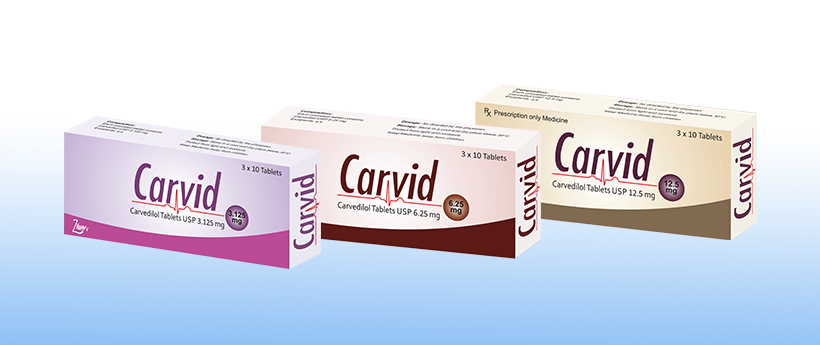Carvid 3.125 / 6.25 / 12.5
- ENG
- မြန်မာ

CARVID 3.125 (Carvediol 3.125 mg Tablets)
Each uncoated tablet contains:
Carvedilol BP 3.125mg
Excipients q.s.
CARVID 6.25 (Carvediol 6.25 mg Tablets)
Each uncoated tablet contains:
Carvedilol BP 6.25mg
Excipients q.s.
Colour: Quinoline Yellow
CARVID 12.5 (Carvediol 12.5 mg Tablets)
Each uncoated tablet contains:
Carvedilol BP 12.5mg
Excipients q.s.
Colour: Erythrosine
DESCRIPTION
Carvedilol is a competitive non-selective beta 1 and 2-adrenergic blocking agent with also alpha-adrenergic blocking activity and no intrinsic sympathomimetic activity. Carvedilol reduces peripheral vascular resistance through vasodilation and suppresses the renin-agiotensin-aldosterone system through beta blockade.
INDICATIONS
- Hypertension
- Angina Pectoris
- Adjunct to diuretics, digoxin, or ACE inhibitors in symptomatic chronic heart failure.
DOSAGE & ADMINISTRATION
In hypertension, initial oral dose of 12.5 mg once daily. Increased after 2 days to usual dose of 25mg once daily,
Elderly initial dose of 12.5 mg daily may provide satisfactory control.
In angina pectoris an initial oral dose of 12.5 mg is given twice daily, increased after two days to 25mg twice daily.
Adjunct in heart failure initially 3.125 mg twice daily (with food), dose increased at intervals of at least 2 weeks of 6.25 mg twice daily; increase to highest dose tolerated, max. 25mg twice daily in patients with severe heart failure or body weight less than 85 kg and 52 mg twice daily in patients over 85 kg.
CONTRAINDICATIONS
Carvid is contra-indicated in patients with marked fluid retention or overload requiring intravenous inotropic support.
Patients with obstructive airways disease, liver dysfunction, hypersensitivity to carvedilol or any other constituents of the tablets.
As with other beta-blocking agents: History of bronchospasm or asthma, 2nd and 3rd degree A-V heart block, uncontrolled heart failure, Prinzmetal’s angina, severe bradycardia (<50bpm), cardiogenic shock, sick sinus syndrome (including sinoatrial block), severe hypotension (systolic blood pressure < 85mmHg), metabolic acidosis and phaeochromocytoma (unless adequately controlled by alpha blockade).
WARNINGS & PRECAUTIONS
Patients with pheochromocytoma should never receive carvedilol without receiving alpha-adrenoreceptor blocking therapy beforehand or concomitantly.
Carvid should be given to patients with congestive heart failure only after adequate clinical control is achieved, and only then with great caution, especially if the heart failure is controlled with digitals, diuretics and/or ACE inhibitors.
Before the dosage is increased, the patient should be evaluated for symptoms of worsening heart failure or vasodilation. Transient heart failure and fluid retention should be treated with increased doses of a diuretic. It may be necessary to lower the Carvid dosage or to discontinue Carvid therapy temporarily in some cases. All symptoms of vasodilation or worsening heart failure must be stabilsedbefore the dose of Carvid is increased in line with the recommended dosage instructions.
It is of the greatest importance that the anaesthetist be informed that a beta-blocker is being taken by the patient, prior to anaesthesia. Carvid therapy should be discontinued 48 hours prior to anaesthesia. If this is not possible, an agent such as atropine may be administered to counter increases in vegal tone.
Safety during long-term administration has not been demonstrated.
A dose reduction is necessary in elderly patients, or in patients suffering from renal dysfunction. Abrupt discontinuation of therapy may cause exacerbation of angina pectoris in patients suffering from ischaemic heart disease.
Discontinuation of therapy should be gradual (over a period of 1 to 2 weeks) and patients should be advised to limit the extent of their physical activity during the period that the medicine is being discontinued.
DRUG-INTERACTIONS
Caution should be exercised when transferring a patient from clonidine. The withdrawl of clonidine may result in the release of large amounts of catecholamines which may give rise to a hypertensive crisis.
PREGNANCY AND LACTATION
Carvid should not be used during pregnancy and lactation. Administrtion to pregnant mothers shortly before giving birth, or during labour, may result in the newborn infant being born hypotonic, collapsed and hypoglycaemic.
UNDERSIRABLE EFFECTS
The following side-effects may occur:
Cardiovascular, Postural hypotension and bradycardia can occur.
Congestive cardiac failure can be precipiated or worsened, especially during dose titration. Heart block may be precipitated in patients with underlying cardiac disorders. Chest pain, generalized oedema and syncope have also been reported.
Respiratory: Bronchoconstriction, wheeze and dyspnoea may occur in patients with asthma, bronchitis and other chronic pulmonary diseases.
Gastro-intestinal and hepatobiliary: Diarrhoea, nausea , vomiting, constipation, abdominal cramps and hepatic injury (elevated transaminases) have been reported.
General: Vague fatigue and malaise, which is usually mild and occurs particularly after initiation of therapy. Stuffy nose, fever and weight gain occurs rarely.
Urogenital: Sexual impotence, reduced libido, hematuria, urine retention and deterioration of renal function in patients with CHF.
Musculoskeletal: Muscle weakness, muscle cramps, myopathies and cold extremities.
Neuropsychiatric: This may range from vague fatigue and malaise, isomnia, vivid dreams and nightmares, to overt psychosis. Paresthesia( including tingling of the scalp) and peripheral neuropathy have also been reported.
Haematological: Non-thrombocytopenic purpura, thrombocytopenia, agranulocytosis, transient eosinophilia and leucopenia.
Dermatological: Allergic skin reactions, reversible alopecia, stomatitis and angioedema. Psoriasis may be aggravated or induced by carvedilol.
DESCRIPTION
Carvedilol is a competitive non-selective beta 1 and 2-adrenergic blocking agent with also alpha-adrenergic blocking activity and no intrinsic sympathomimetic activity.
PRESENTATION
3 blisters containing 10 tablets each are packed in a primary carton along with the Pack Insert.





